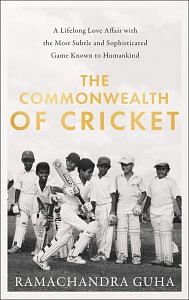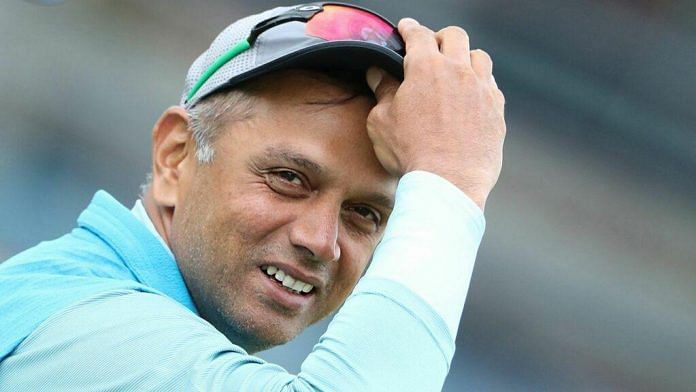As with Anil Kumble, I wrote in praise of Rahul Dravid long before I met him. After his impressive debut at Lord’s in 1996, Dravid was a fixture in the Test side, but seen as too orthodox and unadventurous to be included in the one-day team. A clever copywriter had named him ‘The Wall’, an appellation to be upheld if India were playing Tests, but to be deplored for the 50-overs game. In August 1998, with a long series of one-day games about to commence, a large hoarding featuring Dravid came down at one of Bangalore’s busiest intersections, the corner of Brigade Road and Residency Road. When it became clear that the Karnataka batsman was not part of India’s one-day plans, the admen chose to market somebody or something else. I protested as follows in the pages of The Hindu:
Even if Dravid never again lends his face to a product, I would like to raise two cheers for his batsmanship. For the skilled practitioner of tuk-tuk can do more than draw Test matches. He can help win them too. Don Bradman’s Australian team of the Thirties and Forties always had one artful blocker [first Ponsford, then Sid Brown]. In the greatest of modern Test sides, the West Indies as they were between 1977–85, the thunder was stolen by the dasher-and-bashers, by Greenidge, Richards, Fredericks, Kallicharran and Lloyd, yet they could bat freely only because the now forgotten Larry Gomes kept one end going for long periods. …
Why go back so far in time? Think only of February and March of this year [1998], and India’s surprising victory over the self-appointed world champions. The batting headlines in that series against Australia were claimed by Sidhu, Azharuddin and, above all, Tendulkar. But their sparkle and fizz was only, so to say, more flower on the Wall. These strokemakers took Dravid’s calm solidity for granted. But after Mark Taylor’s men went home, the silly season began.
This was written as a double partisan, of Karnataka and of Test cricket. Yet in so lavishly praising Dravid’s batsmanship I had fallen into stereotyping him. Without ever abandoning the orthodox bedrock on which his game rested, Dravid learnt to hit harder and higher. He muscled his way into the one-day squad, showing the selectors (and the admen) that he could, when the occasion demanded, play across the line and hit sixes too. Besides, he could fill in as a wicketkeeper if the balance of the team so required. As a boy, Dravid had kept wickets for his school team, while his club, the BUCC, was also the club of India’s greatest ever stumper, Syed Kirmani. Now, he brought out his gloves and his memories, and became an adequate keeper. In the event he was to play more than three hundred one-day matches for India, scoring twelve hundreds and as many as eighty-three fifties in them.
Also read: Broken bones, fractured jaws, bruised egos — The lesser-known tale of India’s pace bowling
If memory serves, I first shook hands with Dravid at a function on the eve of the 2005 Bangalore Test between India and Pakistan. Srinath, who had by now retired, made the main speech, urging the man he called ‘a living legend’ to give his hometown crowd a century the next day. In the event, Dravid did not oblige—his record at the Chinnaswamy Stadium was as modest as Sachin Tendulkar’s at Lord’s—but, since he scored plenty of hundreds elsewhere, he has remained our boy always.
For some odd reason, most of my meetings with Dravid have been at airports. Once, when he was captain of Karnataka as well as of India, I berated him (politely) in front of some airline stewards for the state selectors’ neglect of a first-rate all-rounder from (where else) the Friends Union Cricket Club. Another time, we met at the check-in counter on a day when a writer we knew had been awarded the Padma Bhushan. Dravid thought it interesting that the recipient had not been awarded a Padma Shri before (something no other Indian cricketer might have noticed).
That day, we were in the same flight, but while I was in business class, Dravid was in economy—a temporary reversal of fortune, explained by the fact that I was going to address a bunch of company executives, whereas Dravid was travelling with the Karnataka Ranji team. I felt guilty, and as soon as the safety- belt sign had been switched off went looking for my lads. I saw the fast bowler R. Vinay Kumar jumping around in his seat, his ears plugged, listening to rock music. Next to him was the most intelligent cricketer ever to play for my state or my country, deep into the pages of Nandan Nilekani’s recently published book, Imagining India.
Also read: Brand Virat Kohli and how he became the world’s most marketable cricketer
Dravid had once even read a book of mine, about which I learnt in the most curious way. In 2007, India were playing a one-day series in England. Dravid was captain, but not keeping wicket (M.S. Dhoni was). One would have expected him to stand at slip, but he had placed himself at mid-off, perhaps to advise the bowler and have a clearer picture of the field. After a match in which two or perhaps three catches had been put down in the slips, I wrote to the India captain from my home in Bangalore:
Dear Rahul,
You are quite possibly the finest Test batsman in Indian cricket history, and without question the finest slip fielder ever produced by India in ALL forms of the game. You must field there. I understand that with your somewhat erratic bowling you feel the need to be close at hand to guide them. But, all things considered. I think that slip is the place for you, and for the team. No one else in India is remotely as good as you, which is why all these catches go down in the early overs.
With regards
Ram
Two or three days later a reply came back. This did not refer to my request, but instead noted that he had bought a book I had just published on the history of independent India. ‘You are right,’ remarked the Indian cricket captain, that ‘all our history seemed to stop with Gandhi and there’s actually so much that’s happened since for us to be where we are 60 years later. I finished about 180 pages so a fair way to go. Would love to talk about it and much more.’
My email to Dravid was unsolicited, unprompted and impertinent—akin in cricketing terms to a bouncer from a bowler of military medium pace, it was dispatched to the boundary with a flick of the wrists. The put-down was decisive; and yet so delicately worded. I was told, in the kindest possible manner, to shut up about strategy in cricket and go back to writing history books. (I did.)
 This edited excerpt from The Commonwealth of Cricket: A Lifelong Love Affair with the Most Subtle and Sophisticated Game Known to Humankind by Ramachandra Guha has been published with permission from HarperCollins India.
This edited excerpt from The Commonwealth of Cricket: A Lifelong Love Affair with the Most Subtle and Sophisticated Game Known to Humankind by Ramachandra Guha has been published with permission from HarperCollins India.




Didn’t know Dravid was such non-receptive of ideas: he should have given a thought to your input and responded, instead of cold-shouldering the same.
Guha is a delight to read when he writes cricket. Perhaps my advice to him is the reverse of what Rahul gave him. Stick to cricket rather than court controversies elsewhere. This is no time for sane debate and discussion
Without beating around the Bush, I would say ,Rahul Dravid personifies the distilled essence of the magnificent game called Cricket!
at last somebody said what so many of us were wanting to say for a long time. of course not only about cricket strategy but about anything!!
This silly article is nothing but an attempt to fool people into thinking “oh… Guha likes cricket so is a regular guy, he must be just like us, a nice guy”.
Don’t forget for one moment that this fellow is an anti-national & a closet Islamist & commie. He has done incalculable harm to India, our Dharma & image.
You are an idiot
Just how Mr Laal ? CAre to back up your preposterous claim about Mr Guha with some facts ?
Tragedy of this stage of human evolution is that the intellectuals ( some real, some self proclaimed) have become commercial doing salesmanship of their ware by advertising just as Lux is marketed.
Ram has become too full of himself. Why he cannot talk and be seen less I fail to understand. Silence is golden. Surely he knows and would do good to practice it.
Ram Guha should write pamphlet slogans or proofread Congress party manifestos for mistakes not history books – he is less worse in cricket history.
Rahul Dravid is the most sophisticated Indian cricketer and talented too. That’s incredible.
Undermining the spirit of journalism. Your lack of competence of good content and presentation can’t be compensated by cheap catchy headlines. Grow up.
Thanks again Mr Guha, yet again u managed to make us read ur non sense, the heading had nothing to do with the article, but we understand its ur marketing technique to let us ur publishing a book.
Looks like Guha is looking for work..each day he keeps dropping names..wasted 10 mins last night reading his article on Adami and today on Dravid..not anymore
Dravid was selected by ganguly only because he kept wickets in 2003 world cup. By this gesture not only ganguly indicated dravid only as a bstsman was not enough but also indicsted india needed a wk who can bat . Great ganguly.
R Guha is a history sheeter
Typical click bait headline.
Dravid has been the finest gentleman to grace the field of cricket and somehow, people find a way to try and bring him down to their level.
Print claims to be above such journalism and yet, here we see an all too familiar pattern.
Do better next time
Why does the headline say Dravid said to shut up. He didn’t say those words.
These are not the words you associate with Dravid.
Somebody has to play a hook shot against the history bit too!!!
Before a batsman executes a hook he reads the delivery through and through. You should first read whatever history book you choose for your intended hook shot.
True. Sir, my comments are after reading the ball from the time it is held in the bowlers’s arm, delivery, in the air, movement off the pitch and of course the overall pace. Once you know how the bowler generally delivers, it is easy to go on the back foot and position yourself well for the hook.
Of course, there is a choice to duck too, and leave the ball.
In my view, Rahul Dravid is the greatest Test Batsman for sure, and one of the greatest batsmen overall to play for India. Barring Haryana Hurricane Kapil Dev, no player can lay claim to being the most selfless player who ever played for India, except Dravid.
True
Absolutely right.
Reading this article was a total waste of time. This comes across as very boring read written by a self obsessed self important writer. Do not read this book. Use your time to read something worthwhile. Article headline was a click bait. Why does Shekhar Gupta allows such trash to be published. He does not have respect for readers time and intellect. Wasted 10 minutes of my life. I want it back, SHEKHAR, how dare you.
This is exactly why I love reading Ram Guha.
Sadly his political commentary these days is highly colored and partisan, which I feel, undermines his own credibility.